|
Mitigation program for landslide-prone areas:
NBRO warns residents
By Mohammed Naalir
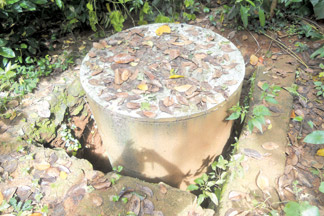
A subsided location in the Thotagamuwa junction.
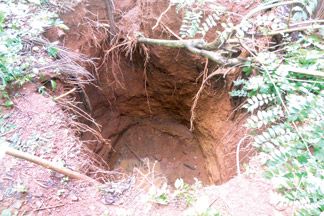
Another subsided site in the Thotagamuwa junction area. |
 |
|
Landslide Studies and
Services Division Head, NBRO R.M.S. Bandara. |
The National Building Research Organisation (NBRO) plans to implement
a mitigation program in locations prone to landslides and along the A-1
Road jointly with the Road Development Authority, Landslide Studies and
Services Division Head, NBRO R.M.S. Bandara said.
He said the NBRO has held discussions with the Japanese International
Cooperation Agency (JICA) in regard to the proposed program and JICA
will provide technical and financial assistance.
Bandara was confident that the proposed mitigation program will
commence before the end of the year.
He said it is an opportunity for our mitigation workers to study the
Japanese landslide mitigation technology. The NBRO will be able to
implement mitigation programs without the assistance of others in the
future.
The mapping of landslide and subsidence prone areas is nearing
completion. Over 90 percent of the work is over now. The next focus of
the NBRO is to mitigate identified landslide sites. A proposal has also
been submitted to the relevant authorities in regard to this program.
"The NBRO plans to conduct landslide as well as subsidence awareness
programs targeting executive range officers and people in the grassroots
level", Bandara said.
"Necessary arrangements have been made to give early warnings to
people living in areas vulnerable to subsidence or landslides. Automated
rain gauges will be set up at suitable locations. People will be given
instructions and timely warnings in case of any landslide or subsidence
threat due to heavy rains. The assistance of the Meteorology Department
will be obtained in the process", the Landslide Division Head said.
"The recent landslides claimed 22 lives in the Matale district.
Subsidence is the other major problem in the district. The NBRO
conducted a survey in the Matale district in 2008 in connection with
subsidence and has mapped out locations prone to subsidence", Bandara
said.
The maps have been given to local authorities such as Pradeshiya
Sabras and Divisional Secretariats. The people who live in areas
vulnerable to landslides or subsidence have been instructed to be
vigilant and refrain from building houses or other structures in such
areas, the Landslide Division Head said.
"The NBRO has identified a number of subsidence prone locations in
the Thotagamuwa junction, Matale. Two subsidences were reported in the
area in December 2012, accompanied by heavy rains", Bandara said.
"The NBRO conducted a thorough study in the area and found there were
nearly 15 to 20 cavities underground", he said.
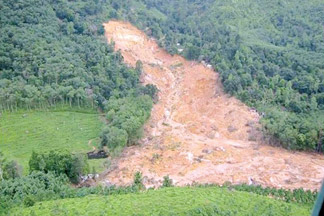
Alapatha landslide. |
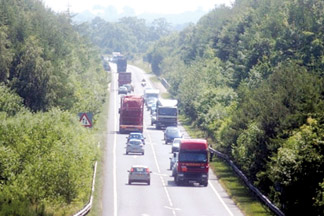
A stretch of the A-1 Road. |
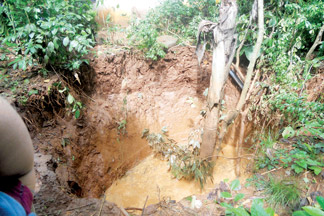
A subsided place in Palapathwala, Matale. |
"Cavities are formed due to the pressure of water. A limestone layer
is seen underground. Due to the water fluctuation there is a possibility
of limestone erosion. As the limestone is eroded a cavity is formed in
the rock. When these cavities grow bigger the earth will go down or
sink. This process is called subsidence", Bandara said.
Subsidence may occur even in flat lands. It is a sudden occurrence
and is dangerous. It can occur overnight if the water fluctuation is
high underground, Bandara said.
He said after last year's subsidence in the Matale district, no
incidents were reported in the area. The Matale District is vulnerable
to both landslides and subsidence, he said. Areas with castaic marble
formation are vulnerable to subsidence. Any place in the world with this
structure is no exception to subsidence.
Residents in subsidence prone areas will be relocated to safe areas,
Matale District Secretariat sources said. They said residents in various
areas in Matale such as Rattota and Ukuwela Division who are at risk
will be resettled in safer locations, and the relocation program is
being conducted with the guidance of the NBRO.
"There are subsidence prone locations in South Africa as well as
Australia. If there is a marble formation underground those areas will
definitely become vulnerable to subsidence. Even big houses may sink
underground. In other countries houses have also sunk, but not so in Sri
Lanka", Bandara said.
The NBRO has cautioned the people to pay maximum attention to the
condition of land before commencing buildings or other structures. The
NBRO has deployed its officers to the relevant areas and they are kept
in vigil round the clock to help the residents. People have also been
asked to inform the NBRO about cracks appearing on the walls of houses
and changes occurring in the ground.
Landslide is a different phenomena when compared with subsidence.
Landslides may occur due to the fall of cuttings, and bad land practice.
Falling of rock, debris, slope angle, heavy rainfalls, geological
conditions, water conditions and drainage systems are the causes of
landslides.
The sinking of the earth structure is known as subsidence. Due to
various reasons such as gem mining subsidence could occur, especially in
the Ratnapura district. Subsidence is possible in places where people
engage in mining.
There could be cavities in rocks. Houses and giant structures are
constructed on rocks. But people are not aware of the underground
condition. If there is a cavity in the rock, it may go down or sink any
time. People who construct houses and other structures should conduct a
thorough study on the condition of the underground.
"Subsidence is concerned with soil thickness, water conditions and
cavities. Mitigation work is not possible against subsidence. If there
are many cavities in the rock sending soil or applying concrete layers
are not possible. Mitigation works cannot be carried out to counter
natural subsidence. Some countries use the identified subsidence areas
for crop and vegetable cultivation", the Landslide Divison Head said.
Land subsidence occurs when large amounts of ground water have been
withdrawn from certain types of rocks, such as fine-grained sediments.
The rock compacts because the water is partly responsible for holding
the ground up. When the water is withdrawn, the rock falls in on itself.
You may not notice land subsidence too much because it can occur over
large areas rather than in a small spot, such as a sink hole Bandara
said.
It doesn't mean that subsidence is not a big event. States such as
California, Texas and Florida have suffered damage to the tune of
hundreds of millions of dollars over the years, due to subsidence.
The reaction of water in the marble bands underground is the
technical reason for land subsidence. It will take place in certain
areas, but landslides may occur in any place. Landslide is also very
dangerous. Already we have mapped out subsidence locations and given it
to relevant local authorities", Bandara said.
The NBRO has created awareness among the public about subsidence and
landslides through the local authorities, but the people forget
everything in due course. They start talking about it only when an
incident takes place", the Landslide Division Head said.
The Landslide Research and Risk Management Division of NBRO has
implemented a landslide hazard zonation mapping program within the 10
landslide prone districts of Kalutara, Galle, Hambantota, Nuwara Eliya,
Matale, Kandy, Kegalle, Ratnapura, Matara and Badulla.
|



